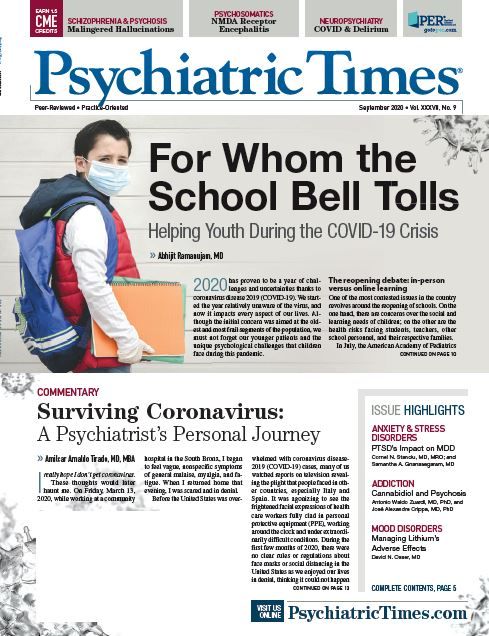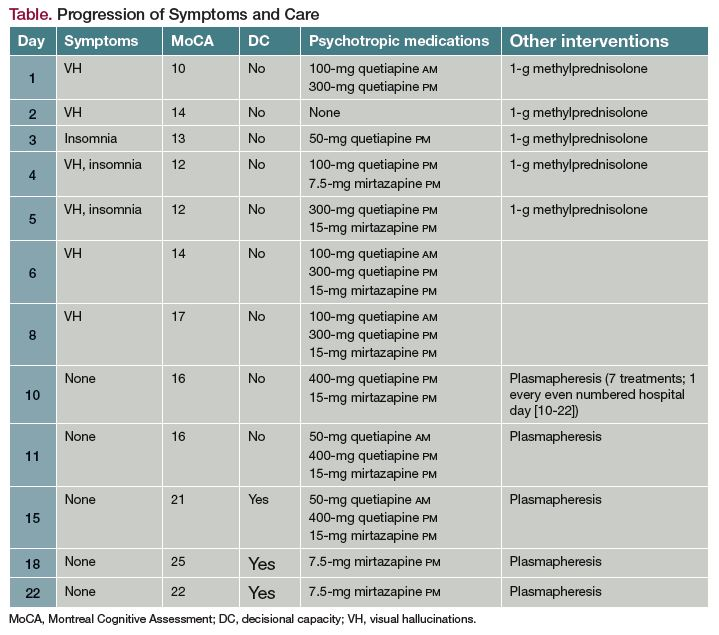Publication
Article
Psychiatric Times
Anti-NMDA Receptor Encephalitis With Visual Hallucinations and Cognitive Impairment
Author(s):
In comparison to the classic presentation of schizophrenia, ANMDARE features a later age of onset, female predominance, visual hallucinations, relative lack of cognitive disorganization, and a lack of an extended prodromal period.
FROM THE ACADEMY OF CONSULTATION-LIAISON PSYCHIATRY
CASE REPORT
“Ms Zorn” was a 45-year-old woman with no previous psychiatric history who presented with a 2-month period of “feeling like I am losing myself” and seeing “visually distorted faces.” Faces of people she was looking at would appear to be hideously elongated, with the facial components distorted, as if it was melting. Cars would also appear to be more round than usual.
She was admitted to an inpatient psychiatry unit for unspecified psychosis, but after 2 days she was transferred to a general medical unit for additional medical evaluation. She was started on 25-mg quetiapine bid, which was titrated to 200 mg bid. Lumbar puncture was completed to rule out central nervous system infection or autoimmune encephalopathy, with results pending at the time of transfer to an academic medical center for higher level of multispecialty care.
On interview, she said that she felt like she was “losing” herself and reported visual distortions of “faces melting.” Ms Zorn was able to recognize faces and colors. She reported photophobia. She had headaches, which were relieved with ketorolac. Her husband reported that she had new onset of episodes of shaking her arms in a circular motion. She would also walk around the room in circular patterns while saying to herself that she was “lost.”
Ms Zorn had decreased appetite, weight loss, and decreased sleep. She denied depressed mood, decreased energy, mania, trauma, or previous problems with memory. She denied auditory hallucinations and suicidal/homicidal ideation. She denied a family history of suicide and psychiatric illness. Developmental history was unremarkable. She had no history of substance abuse.
On mental status examination, she was awake, alert, oriented to person, time, place, and situation. She continued to experience visual distortions of “faces melting.” Ms Zorn’s thought process was linear and coherent. Affect was mildly anxiously perplexed, non-labile, and non-tearful. Speech was normal. Insight and judgment were marginal. Her Montreal Cognitive Assessment (MoCA) score was 10/30. Her decisional capacity was impaired, and the screening neurological examination was non-focal.
Due to the atypical presentation of psychotic disorder, the full workup included a neurology consultation; brain MRI and lumbar puncture results were normal, except for autoimmune encephalitis results that were pending. Serum HIV, syphilis, vitamin B12, lead, rapid plasma regain (RPR), anti-nuclear antibody ammonia, and thyroid stimulating hormone (TSH) levels were normal; EEG was unremarkable. Pelvic ultrasound and CT were ordered to rule out ovarian teratoma. Quetiapine regimen was changed to 100 mg in the morning and 300 mg in the evening.
Ms Zorn was seen in follow-up on hospital day 2. Neurology had started her on 1-g methylprednisolone daily for a 5-day course for presumed autoimmune encephalitis. She was placed on a continuous EEG. On exam, she reported feeling better compared with the previous day. She no longer reported any distortions of faces or objects in the room, although she did report some “blue dots” in her field of view. She had 3 hours of sleep the previous night. Her husband noted that the she had decreased episodes of her aimless pattern of waving her arms in a circular motion. Her MoCA score was 14/30. Due to the significant improvement in her hallucinations following the first dose of methylprednisolone, the scheduled quetiapine was held.
When seen on hospital day 3, Ms Zorn said that she could fall asleep, but had trouble staying asleep. She had an episode where she got up and walked around the room purposelessly. Her MoCA score was 13/30 and decisional capacity was impaired. Quetiapine 50 mg post merdien (PM) was started to address poor sleep. On hospital day 4, she reported that her visual phenomena had returned, with her seeing “pixels” (flashing punctate lights) and “faces melting.” She had had difficulty sleeping. MoCA was 12/30 with continued limited insight, judgment, and decisional capacity. Quetiapine was increased to 100 mg pm and mirtazapine 7.5 mg pm was started to improve sleep.
On hospital day 5, her husband reported that she had had continued visual phenomena of pixels and faces melting. Ms Zorn was only able to sleep for 1.5 hours after receiving quetiapine and mirtazapine. On exam, she reported the visual hallucinations and had a MoCA score of 12/30. Continuous EEG was reported as normal and abdomen CT was negative for ovarian teratoma. To address continued psychosis and poor sleep, quetiapine was increased to 100 mg am and 300 mg pm. Mirtazapine was increased to 15 mg pm.
Ms Zorn was seen again on hospital day 6. She reported that she had been able to sleep for 8 hours. She denied any visual “melting” of faces but stated that the “world looked pixelated at times.” MoCA score was 14/30. Subsequently, when seen on hospital day 8, she stated that she was still seeing pixels in the periphery of her visual field. MoCA score improved to 17/30. Quetiapine was consolidated to 400 mg pm.
She was next seen on hospital day 10. The cerebrospinal (CSF) encephalopathy panel came back positive for anti-NMDA receptor antibody R1, confirming a diagnosis of anti-NMDA (N-methyl-D-aspartate)-receptor encephalopathy (ANMDARE). Neurology started plasmapheresis for 7 treatments, every other day. She had no hallucinations. She reported that she was getting “deep sleep.” MoCA score was 16/30. A quetiapine 50 mg am dose was added.
Plasmapheresis started on hospital day 11. The patient denied any visual distortions. She said that she felt significantly better than the previous week; MoCA score was 16/30. When next seen on hospital day 15, Ms Zorn reported sleeping from 11:00 pm to 5:30 am. She denied visual distortions. MoCA score had improved to 21/30; however, decisional capacity continued to be impaired. On hospital day 18, she was doing well. She had declined her scheduled quetiapine the previous day “to give it a try.” She no longer saw distorted faces. She had no gait disturbance. MoCA score improved further to 25/30. Given her improved mental status, the psychiatry team decided that she had recovered her decision-making capacity. Mirtaza-pine was decreased to 7.5 mg pm and quetiapine held.
Ms Zorn was seen for the last time on day 22 of hospital admission. After her final plasmapheresis treatment, she continued to be free of psychotic symptoms. She stated that she was “doing better than last week,” and that she was “80% back to normal.” She was sleeping well and was increasingly physically active during the day. She was excited to return home; MoCA score was 22/30. Decisional capacity continued to be intact. Mirtazapine 7.5 mg bedtime was continued.
As she was medically stable for discharge, she was referred for psychiatric follow-up near her home. She was advised that any future recurrence of psychosis should first be addressed as if it was a recurrence of delirium and/or ANMDARE.
Discussion
ANMDARE is a relatively recently described illness that may present with psychiatric symptoms, neurologic symptoms, or both (either simultaneously or sequentially).1-5 While the exact mechanism remains obscure, antibodies to the NMDA receptor (on CSF and/or serum assay) is confirmatory.2 Management includes empiric treatment of manifest symptoms and immunomodulation systemic therapies.4,5
ANMDARE is important to the consultation-liaison psychiatrist for a number of reasons. First, its presentation lies in the “neuropsychiatric borderland” involving collaboration between psychiatry and neurology (as in other neuropsychiatric illnesses like Parkinson disease, Huntington disease, and multiple sclerosis). Second is its importance in the often hard-to-define syndrome of “atypical psychotic disorder.” In comparison to the classic presentation of schizophrenia, ANMDARE features a later age of onset, female predominance, visual hallucinations, relative lack of cognitive disorganization, and a lack of an extended prodromal period.
This case illustrates the atypical presentation of psychotic illness rather well. Ms Zorn was in her mid-40s, of high academic and professional achievement, adaptive social function; without a clear prodrome, she relatively promptly developed a psychotic picture with striking and disturbing visual hallucinatory phenomena. Clinical suspicion for ANMDARE was confirmed with reference laboratory (Mayo Clinic) results of + R1 antibody to NMDA receptor on CSF analysis. This was accomplished in the context of a thorough laboratory evaluation for other esoteric causes of atypical psychotic illness.
Empiric treatment of the psychiatric symptoms with mirtazapine and quetiapine, concurrent with 2 rounds of immunomodulation therapy, led to amelioration of symptoms and near complete cognitive recovery in a period of 2.5 weeks. Her cognitive status based on objective measure with the Montreal Cognitive Assessment (MoCA) was initially in the moderate to severely impaired range.6 With comprehensive treatment, Ms Zorn’s cognitive status improved to a level of only mild impairment. Correspondingly, her decisional capacity improved from significantly impaired to largely intact over the same period.
Psychiatrists assessing and treating patients with atypical presentation of psychotic illness should actively consider a diagnosis of ANMDARE as explanatory.3,4 In female patients with suspicion of ANMDARE, pelvic ultrasonography and/or CT scan should be ordered to rule out commonly co-occurring ovarian teratoma.1 Patients with ANMDARE who are treated with high-dose intravenous corticosteroids should be monitored (and treated for) any corticosteroid-associated psychiatric adverse effects, which can overlap with the atypical psychotic symptoms at illness onset. Empiric treatment with psychopharmacology for psychotic and/or depressive symptoms should be pursued, although such medications may not be necessary indefinitely once definitive immunomodulation therapy is completed.4
ANMDARE should be on the differential for atypical psychosis, with an expectation of a thorough search for laboratory and systemic clinical (especially neurologic) findings, empiric treatment of psychiatric symptoms, and reassessment of the patient as immunomodulation therapy is completed. Prospective study of ANMDARE illness cohorts are needed to quantify recurrence risk, need for ongoing intervention, and ultimate prognosis.
Consultation-liaison psychiatrists working in academic medical centers may be in a position to assist multispecialty teams in the identification, diagnosis, management, and ongoing follow-up of these patients. As with any illness that affects cognitive function, attention to and serial assessment of decisional capacity is a critical part of C-L psychiatry care, especially as pertains to patient consent for major immunomodulation therapies.
Dr Bourgeois is chair, Department of Psychiatry, Baylor Scott & White Health, Central Texas Division, and clinical professor for medical education, Texas A&M University Health Science Center, Temple, TX. Mr Li is a medical student, Texas A&M University Health Science Center, Temple, TX. The authors report no conflicts of interest concerning the subject matter of this article.
References
1. Tuzun E, Zhou L, Baehring JM, et al. Evidence for antibody-mediated pathogenesis in anti-NMDAR encephalitis associated with ovarian teratoma. Acta Neuropathol. 2009;118:737-743.
2. Gresa-Arribas N, Titulaer MJ, Torrents A, et al. Antibody titres at diagnosis and during follow-up of anti-NMDA receptor encephalitis: a retrospective study. Lancet Neurol. 2014;13:167-177.
3. Kayser MS, Titulaer MJ, Gresa-Arribas N, Dalmau J. Frequency and characteristics of isolated psychiatric episodes in anti-N-methyl-d-aspartate receptor encephalitis. JAMA Neurol. 2013;70:1133-1139.
4. Warren N, O’Gorman C, McKeon G, et al. Psychiatric management of anti-NMDAR encephalitis: a cohort analysis. Psychol Med. November 19, 2019; Epub ahead of print.
5. Titulaer MJ, McCracken L, Gabilondo I, et al. Treatment and prognostic factors for long-term outcome in patients with anti-NMDA receptor encephalitis: an observational cohort study. Lancet Neurol. 2013;12:157-165.
6. Nasreddine Z. Montreal Cognitive Assessment (MoCA) Administration and Scoring Instructions. Montreal Cognitive Assessment. Accessed July 9, 2020. http://www.mocatest.org/wp-content/uploads/2015/tests-instructions/MoCA-Instructions-English_2010.pdf .❒








